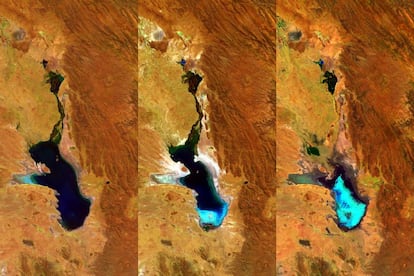Bolivia’s second-largest lake is evaporating, say European scientists
Space agency satellite confirms Lake Poopó has shrunk in size in just under two years

New images from the European Space Agency’s (ESA) minisatellite Proba-V, which studies changes on the Earth’s surface, has revealed that the second-largest lake in Bolivia is slowly evaporating.
Lake Poopó, which is located on a mountain range in Bolivia’s Altiplano region, once covered 3,000 square kilometers and was bigger in area than the French island of Reunion.
Lake Poopó was once larger than the French island of Reunion
But a series of images taken by Proba-V – on April, 27, 2014; July 20, 2015; and January 22, 2016 – show that the lake is shrinking in size.
According to scientists, arid mountain air makes Lake Poopó, which is only about three meters deep, susceptible to climate change.
In December, Lake Poopó’s evaporation was officially confirmed. And while this is not the first time the lake has begun to evaporate – the last time reported was in 1994 – there are concerns that it will now take years to replenish the water, if it eventually occurs.
Area fishermen have complained about the drops in their catches while the lake’s ecosystem appears to be greatly endangered.
Lake Poopó is recognized under the Ramsar Convention as a protected wetland area.
Miners and farmers in the region are also to blame for diminishing the lake’s water supplies, as well as the drought caused by climatic changes brought on by El Niño.
Miners and farmers in the region are also to blame for diminishing the lake’s water supplies
Launched on May 7, 2013, Proba-V is widely used by the ESA to map out Earth’s land surface and study the use of vegetation cover on a daily basis.
“The Proba-V imager’s continent-spanning 2,250 kilometer field of view collects light in the blue, red, near-infrared and mid-infrared wavebands, ideal for monitoring plant and forest growth as well as inland water bodies,” according to the ESA website.
English version by Martin Delfin.
Tu suscripción se está usando en otro dispositivo
¿Quieres añadir otro usuario a tu suscripción?
Si continúas leyendo en este dispositivo, no se podrá leer en el otro.
FlechaTu suscripción se está usando en otro dispositivo y solo puedes acceder a EL PAÍS desde un dispositivo a la vez.
Si quieres compartir tu cuenta, cambia tu suscripción a la modalidad Premium, así podrás añadir otro usuario. Cada uno accederá con su propia cuenta de email, lo que os permitirá personalizar vuestra experiencia en EL PAÍS.
¿Tienes una suscripción de empresa? Accede aquí para contratar más cuentas.
En el caso de no saber quién está usando tu cuenta, te recomendamos cambiar tu contraseña aquí.
Si decides continuar compartiendo tu cuenta, este mensaje se mostrará en tu dispositivo y en el de la otra persona que está usando tu cuenta de forma indefinida, afectando a tu experiencia de lectura. Puedes consultar aquí los términos y condiciones de la suscripción digital.
More information
Últimas noticias
The complicated life of Francesca Albanese: A rising figure in Italy but barred from every bank by Trump’s sanctions
Half of Scotland is in the hands of 420 property owners
How Japan is trying to avert ‘digital defeat’
From digital curfews to blocking apps: How technology experts protect their children online
Most viewed
- Why we lost the habit of sleeping in two segments and how that changed our sense of time
- Trump’s obsession with putting his name on everything is unprecedented in the United States
- Pablo Escobar’s hippos: A serious environmental problem, 40 years on
- The Florida Keys tourist paradise is besieged by immigration agents: ‘We’ve never seen anything like this’
- Charles Dubouloz, mountaineering star, retires at 36 with a farewell tour inspired by Walter Bonatti










































